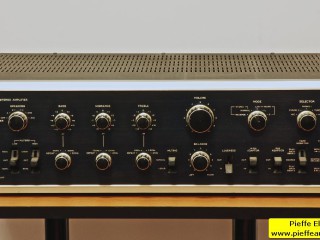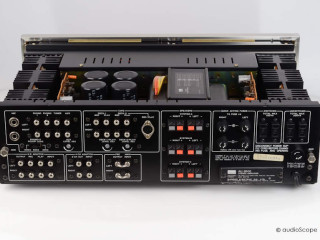
Sansui AU 9500 förstärkare .
Denna förstärkare var en av våra absolut ,bästa förstärkare vid början av 70 – talet ,vi har sålt just detta exemplaret i vår gamla affär Rosens Ljudcenter till en av vår närmsta kund ,som tyvärr inte är med oss längre ( frid över ditt minne Rickard. ) På omvägar så har förstärkaren kommit tillbaks till oss.
Bilderna är inte från vårt ex .
SANSUI AU-9500
135,000yen(October, 1972 release)
Description
The highest-class Integrated Amplifier which the SANSUI completed based on the chosen part making full use of the highest circuitry technology.
The stable whole page hardwired-connection OCL pure complementary circuit is adopted the fully examined component partses and by making full use of a technical expertise. Moreover, by adopting the parallel push-pull circuit which is proud of the Oide power and a low distortion, from 5Hz to 40kHz, the THD, Cross modulation distortion, and Power Band Width from the Koide power to the Oide power also had a margin, and have fully guaranteed 0.1% or less.
A large-sized power transformer and a 4×4,700-micro F mass capacitor are used for a power-source part.
The drive which became independent in the power stage and which adopted the +-2 power-source scheme, raised stability, and had the allowance of a power transistor while carrying out the powering is enabled for every channel.
Furthermore, the power stage and the predrive stage are used as another power source, and the predrive stage is made to drive on a voltage higher than the power stage. For this reason, the drive stabilized without being influenced by the load variation is enabled.
The parallel push circuitry which can reduce the collector current of a power transistor to conventional one half. In this circuitry, since only the good fraction of the current characteristic of a transistor can be chosen, the high output which the whole page hardwired-connection OCL pure complementary circuit and the interval pressed down distortion, and was stabilized as for them can be obtained.
Moreover, by considering the differential amplifier which influences the stability of a whole page hardwired connection as the two-step stream composition by the combination of a low-noise transistor, and carrying out a constant current drive, it is designing so that a parallel push-pull operation may be performed ideally.
The phase margin which plans the stability of amplifier and which is considered as one measure is thought as important.
The robustness under all load-intensity requirements is considered from the equalizer part to [ take greatly enough not only to super-low-pass one but to a super-high region, and ] the main part.
Thereby, to a fundamental wave, a wide range spectrum distribution is carried out, and a character response is shown also to the signal of a pulsive music, and the high-definition tone quality is made possible with the stable operation.
The three-step hardwired-connection equalizer circuitry of PNP-NPN-PNP is used for an equalizer circuitry.
Furthermore, they are 300mV of maximum permissible inputs by the high voltage supplied from the stable constant-voltage regulated power supply.
Moreover, the RIAA deflection which has influence on a tone quality has also guaranteed the value of ±0.5dB to the RIAA element in 30Hz – 15kHz by the low-noise transistor, little resistor with error, and a capacitor.
The it1 noise generated at the time of a switchpoint switching used – power source, and has solved it by setting base potential of the first rank to 0.
When it becomes an overload, the collector current of an output stage and the driver stage builds the current limiter circuit restricted so that beyond a certain constant value may not flow in the protection of a transistor.
At the time of bads, a power transistor and a speaker are protected with an immediate judgment fuse with the relay which combined the electronic circuitry.
Moreover, since the relay circuit serves as the audio muting, there is no unpleasant pop noise at the time of power activation.
A bass and loud sound have adopted T.T.C. (triple tone control) of only ±5dB and the SANSUI from which an ideal curve is obtained by a 1dB step only ±15dB and inside sound at a 3dB step.
T.T.C. In order that amplifier may secure a high input impedance to the first rank, low-noise FET is used for it and it serves as NF type of the three-step hardwired connection and the two-step hardwired-connection circuitry.
The tone quality can make 150Hz of basses, 300Hz, 600Hz, 6kHz of loud sounds, 3.5kHz, and 2kHz an elevation and a descending point by a tone selector circuitry, and inside sound can be adjusted to a total of nine steps focusing on 750Hz, 1.5kHz, and 3kHz.
Moreover, it has the defeet switchpoint and the defeet of the T.T.C. circuitry can be carried out, respectively, and it is designed so that a flat property may be acquired.
The good exclusive NF type active filter circuit system of the piece of 12dB / oct can be adopted, and, as for a high filter, the low filter can change a cut-off frequency to 12kHz and 6kHz at 25Hz and 50Hz.
There is no variation of the frequency response in a mid range.
A sound recording and a play monitor are possible for a tapes monitor circuitry to both those with 2 circuitries, and two simultaneously connected tape decks.
Moreover, tapes reprint can be freely performed from both of the tape decks with a tapes reprint switchpoint. The monitor under reprint is also possible.
And a record, FM, etc. can be ordinarily enjoyed from a speaker, reprinting.
A four-channel stereo system can consist of connecting 4ch adapter.
When not using 4ch adapter, a tape deck is connected and a sound recording and a play monitor are possible.
The tape deck linked to a tapes monitor circuitry to tapes reprint is also possible.
N. By connecting R. (noise reduction) adapter, tape hiss can be reduced and a Hi-Fi sound recording can be carried out simultaneously at two connected tape decks.
Moreover, a play is a switchover of a tapes monitor switchpoint and can be operated with both of the tape decks.
It is possible for A, B, and C to carry three speaker terminations, and to switch independence, A+B, and A+C with a speaker switchpoint, respectively.
Two Phono inputs are carried, and it is designed so that Phono1 may respond to 50kohms, Phono2 may respond to a cartridge and an input impedance may be changed to three steps, 30kohms, 50kohm, and 100kohm.
A preamplifier part and a main-amplifier part can be independently used by removing the connector of the rear panel.
Even if it does not use a volume, the muting switch which can decrease all [ of 20dB ] the compasses is carried.
The level adjuster is taking lessons from Deck1, 2, and AUX, and it is made by unification of each input level, and whenever it is a selector changeover, the volume set which it is can be excluded.
an interconnection of a high impedance type microphone — right and left — it can do separately.
The DIN connector which simplifies an interconnection of a tape deck is carried.
Five positions of Stereo Reverse, Normal, Mono, L+R, L, and R The mode selector is carried.
The loudness circuitry is carried.
The headset jack is equipped two lines, and if one of them inserts headphone, it is the design in which a speaker is turned off automatically.
Two grounding terminals are carried.
Four AC outlets of Switchedx2 and Unswitchedx2 are carried.
All thumbs are the products made from an aluminum Naked.
Rating of a mode
Form Integrated Amplifier
Output power Music power (IHF): 260W (4ohm, 1kHz)
Effective output (one-side-channel operation): 85W/85W (8ohm, 1kHz)
Effective output (both channel operation): 80W+80W (8 ohm, 1kHz)
Succession effective output (both channel operation, the rated distortion of 8 ohm, 20Hz – 20kHz): 75W+75W
THD (Output power) 0.1% or less
Cross modulation distortion 0.1% or less (an Output power, 70Hz:7kHz=4:1, SMPTE)
Power Band Width (IHF) 5Hz – 40kHz
Frequency characteristic 3Hz – 80kHz, and +0 -1 dB (at the time of main-amplifier and 1W output)
Dumping factor 50 (8ohm)
Input sensitivity/input impedance
(1kHz) Phono1:2.5mV/50kohm
Phono2:2.5mV/30kohm, 50kohm, 100kohm
[maximum permissible input 300mV, THD 0.5%or less]
MIC: 2.5mV / 50kohm
Tuner, AUX(level adjustment is possible):100mV /, 50kohm
Tape Monitor1, 2 (PIN) (level adjustment is possible):100mV / 50kohm
2 (DIN):100mV of Tape Monitor / 50kohm
4ch, N.R.Adaptor:100mV /, 50kohm
An Output voltage/Output load impedance Tape Rec1, 2 (PIN):100mV / 1.5kohm
2 (DIN):30mV of Tape Rec / 70kohm
4ch, N.R.Adaptor:100mV /, 1.5kohm
Preamplifier (Output power): 0.8V/1.5kohm
[maximum output and THD 0.5%or less] :4.5V
Crosstalk (Output power 1kHz) Phono1, 2:50dB or more
A hum and a noise (IHF) Phono1, 2:75dB or more
Tuner, AUX: 85dB or more
Main amplifier: 100dB or more
Tone control Bass(Defeat, 150Hz, 300Hz, 600Hz): ±15dB (20Hz), a 3dB step
Midrange(Defeat, 750Hz, 1.5kHz, 3kHz): ±5dB (1.5kHz), a 1dB step
Treble(Defeat, 6kHz, 3.5kHz, 2kHz): ±15dB (20kHz), a 3dB step
Loudness (volume-30dB) 50Hz:+10dB
10kHz:+8dB
A low filter 25Hz, 50Hz:-3dB (12 dB/oct)
A high filter 12kHz, 6kHz:-3dB (12 dB/oct)
The semiconductor used Transistor: 58
FET:2
Diode: 37
Power dissipation 205W (a maximum of 550 VA)
Dimensions Width 500x height 140x depth of 347mm
Weight 23.3kg.
